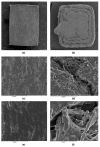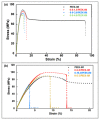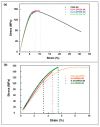Evaluation of Cytocompatibility of PEEK-Based Composites as a Function of Manufacturing Processes
- PMID: 38002451
- PMCID: PMC10669029
- DOI: 10.3390/bioengineering10111327
Evaluation of Cytocompatibility of PEEK-Based Composites as a Function of Manufacturing Processes
Abstract
The biocompatible polymer polyetheretherketone (PEEK) is a suitable candidate to be part of potential all-polymer total joint replacements, provided its use is associated with better osseointegration, mechanical performance, and wear resistance. Seeking to meet the aforementioned requirements, respectively, we have manufactured a PEEK composite with different fillers: carbon fibers (CF), hydroxyapatite particles (HA) and graphene platelets (GNP). The mechanical outcomes of the composites with combinations of 0, 1.5, 3.0 wt% GNP, 5 and 15 wt% HA and 30% of wt% CF concentrations pointed out that one of the best filler combinations to achieve the previous objectives was 30 wt% CF, 8 wt% HA and 2 wt% of GNP. The study compares the bioactivity of human osteoblasts on this composite prepared by injection molding with that on the material manufactured by the Fused Filament Fabrication 3D additive technique. The results indicate that the surface adhesion and proliferation of human osteoblasts over time are better with the composite obtained by injection molding than that obtained by 3D printing. This result is more closely correlated with morphological parameters of the composite surface than its wettability behavior.
Keywords: 3D printing; FFF; PEEK; bioactivity; composite; cytocompatibility; fused filament fabrication; graphene; polyetheretherketone.
Conflict of interest statement
The authors declare no conflict of interest.
Figures









Similar articles
-
The Surface Characterisation of Fused Filament Fabricated (FFF) 3D Printed PEEK/Hydroxyapatite Composites.Polymers (Basel). 2021 Sep 15;13(18):3117. doi: 10.3390/polym13183117. Polymers (Basel). 2021. PMID: 34578018 Free PMC article.
-
The Direct 3D Printing of Functional PEEK/Hydroxyapatite Composites via a Fused Filament Fabrication Approach.Polymers (Basel). 2021 Feb 12;13(4):545. doi: 10.3390/polym13040545. Polymers (Basel). 2021. PMID: 33673299 Free PMC article.
-
Effects of printing path and material components on mechanical properties of 3D-printed polyether-ether-ketone/hydroxyapatite composites.J Mech Behav Biomed Mater. 2021 Jun;118:104475. doi: 10.1016/j.jmbbm.2021.104475. Epub 2021 Mar 20. J Mech Behav Biomed Mater. 2021. PMID: 33773239
-
Applications of 3D-Printed PEEK via Fused Filament Fabrication: A Systematic Review.Polymers (Basel). 2021 Nov 22;13(22):4046. doi: 10.3390/polym13224046. Polymers (Basel). 2021. PMID: 34833346 Free PMC article. Review.
-
Fused Filament Fabrication of PEEK: A Review of Process-Structure-Property Relationships.Polymers (Basel). 2020 Jul 27;12(8):1665. doi: 10.3390/polym12081665. Polymers (Basel). 2020. PMID: 32726994 Free PMC article. Review.
References
-
- Kurtz S.M., editor. PEEK Biomaterials Handbook. 2nd ed. Elsevier; Amsterdam, The Netherlands: 2019.
-
- Stepashkin A.A., Chukov D.I., Senatov F.S., Salimon A.I., Korsunsky A.M., Kaloshkin S.D. 3D-printed PEEK-carbon fiber (CF) composites: Structure and thermal properties. Compos. Sci. Technol. 2018;164:319–326. doi: 10.1016/j.compscitech.2018.05.032. - DOI
-
- Han X., Sharma N., Xu Z., Scheideler L., Geis-Gerstorfer J., Rupp F., Thieringer F.M., Spintzyk S. An In Vitro Study of Osteoblast Response on Fused-Filament Fabrication 3D Printed PEEK for Dental and Cranio-Maxillofacial Implants. J. Clin. Med. 2019;8:771. doi: 10.3390/jcm8060771. - DOI - PMC - PubMed
Grants and funding
LinkOut - more resources
Full Text Sources

